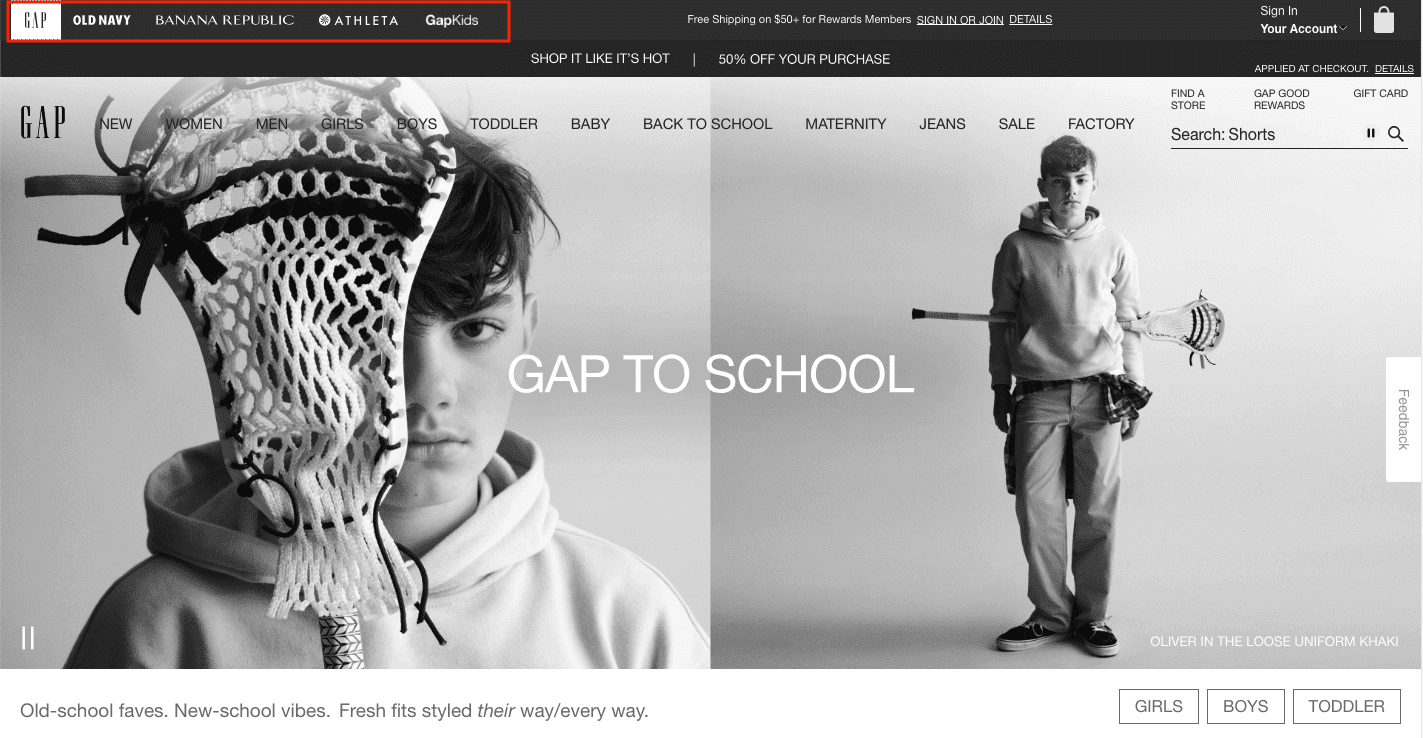34 High-Ticket Affiliate Marketing & Partner Programs 2024 via @sejournal, @kristileilani
Affiliate marketing opens up a world of possibilities for creators, marketers, and entrepreneurs who want to monetize their online presence.
This approach to generating revenue involves three key steps: establishing a connection with your audience, selecting products that resonate with them, and promoting those products.
Whether you manage a blog, have influencer status on social media, or engage your audiences via email, your favorite online platform can be the channel that helps you drive sales and earn affiliate commissions.
This guide offers the best high-ticket affiliate programs for 2024.
Agencies and consultants will also find several partner programs designed for service providers to enhance relationships with existing clients while increasing revenue streams.
How To Get Started With Affiliate Marketing
Here’s a simple summary of how to get started with affiliate marketing.
- Build an audience. Establish a presence online with a high-traffic website, an extensive email list, or influential social media status. Ideally, you can harness the power of all three. Much like a business can’t succeed without customers, you cannot earn commissions without someone to sell to.
- Find products and services you can passionately promote to the audience you have built. Choose products and services you can advocate for with enthusiasm. Authentic passion will make persuading others of the value of your promotion easier.
- Sign up for affiliate and partner programs. These will be offered directly through the company selling the product or service or third-party affiliate platforms.
- Fill out your application and affiliate profile completely. Include the details about your specific niche, website visitors, subscriber counts, and the reach of your social platforms.
- Get your custom affiliate or referral link and share it with your audience. If you have a list with diverse interests, you may want to segment your audience to promote targeted offers that benefit them most.
- Adhere to FTC and legal guidelines. Most affiliate programs require affiliates to be transparent with disclosures for affiliate links and banners.
- Look for opportunities to recommend products to new people. You can be helpful in many ways online, such as answering questions on X (Twitter), Reddit, and Quora. This may drive new people to your blog or social posts about the products you promote.
- Create content that appeals to businesses. Sales for businesses, teams, and enterprises will generate higher affiliate commissions than individual user sales.
- Monitor your affiliate dashboard and website analytics for insights into your clicks and commissions. It can help you identify the channels that drive the most return on investment (ROI).
- Adjust your affiliate marketing tactics based on the most revenue promotions.
Now, continue reading about the best high-ticket affiliate programs you can sign up for in 2024. They offer a high one-time payout, recurring commissions, or both.
The ‘Best’ High-Ticket Affiliate Marketing & Partner Programs
What makes these affiliate marketing programs the “best” is subjective. You can always check the ratings for companies and products on sites like G2, GetApp, and TrustRadius.
You can also use reviews from those sites to discover impressive results customers gained from using the product and the features customers love most. Use those in your blog posts, emails, or social media content to help more people purchase – ideally with your affiliate link.
Productivity Software
1. Google Workspace Affiliate
Google Workspace offers a referral and affiliate program, allowing you to earn income from promoting Gmail, Google Meet, and Drive.
 Screenshot from Google, March 2024
Screenshot from Google, March 20242. Microsoft For Business Affiliate Program
The Microsoft for Business affiliate program offers commissions on sales of Surface devices and accessories and a bounty for each Microsoft 365 seat sold to new customers, with the bounty varying by product.
For example, if your business refers a company that buys Microsoft 365 Business Standard with 50 seats at a $15 per seat commission, it generates $750.
Joining the program is free, with no minimum sales requirement, and provides a 14 to 30-day referral window to earn commissions.
3. Zoho
Zoho offers 55+ productivity and marketing products to help businesses scale.
The company’s affiliate program allows participants to earn up to 15% commission on every qualified sale for the first year, with a 90-day cookie duration to track referrals.
Top affiliates in Zoho’s affiliate program earn $100,000 in commissions annually.
Additionally, customers who purchase through an affiliate link receive $100 in wallet credits to explore Zoho’s offerings.
Project Management Software
4. Asana Partner Program
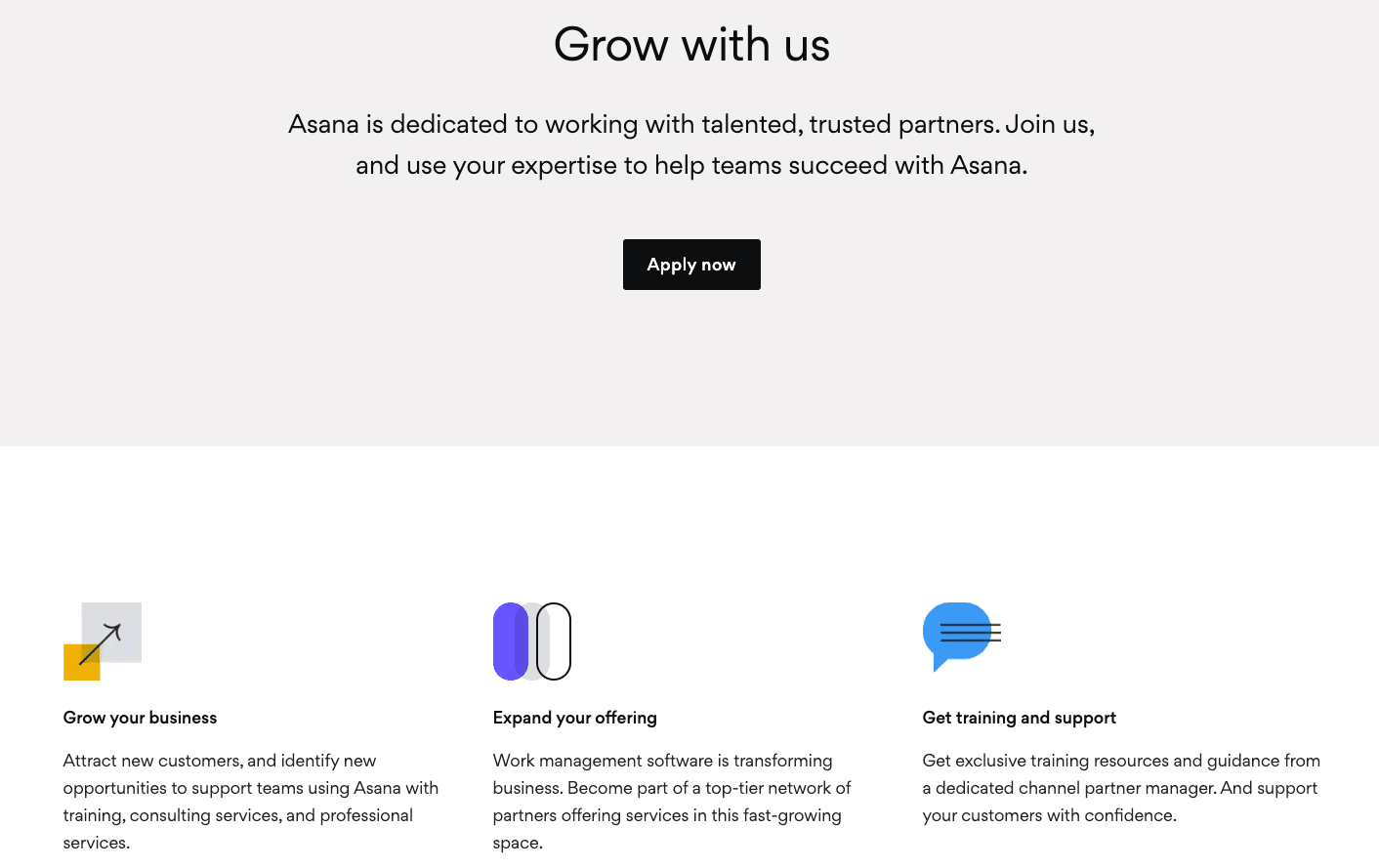


The Asana Partner Program allows customers of its project management tool to attract new customers through training, consulting, and professional services.
Participants gain access to exclusive training resources, dedicated support from a channel partner manager, and the opportunity to bolster their service offerings within a growing network of top-tier partners.
5. Monday
Monday.com offers an affiliate program to promote its global project planning platform with over 150,000 customers.
The program includes access to a wealth of marketing resources and the opportunity to earn up to 100% commission in the first year for each customer referral, with payments facilitated monthly via PayPal or Stripe.
6. Teamwork
Teamwork, project management software focused on maximizing billable hours, helps everyone in your organization become more efficient – from the founder to the project managers.
By referring new customers, participants receive 15% of every payment made to Teamwork.com by the referred individual, up to a maximum of $1,000 per referral.
Marketing Research Tools
7. Semrush
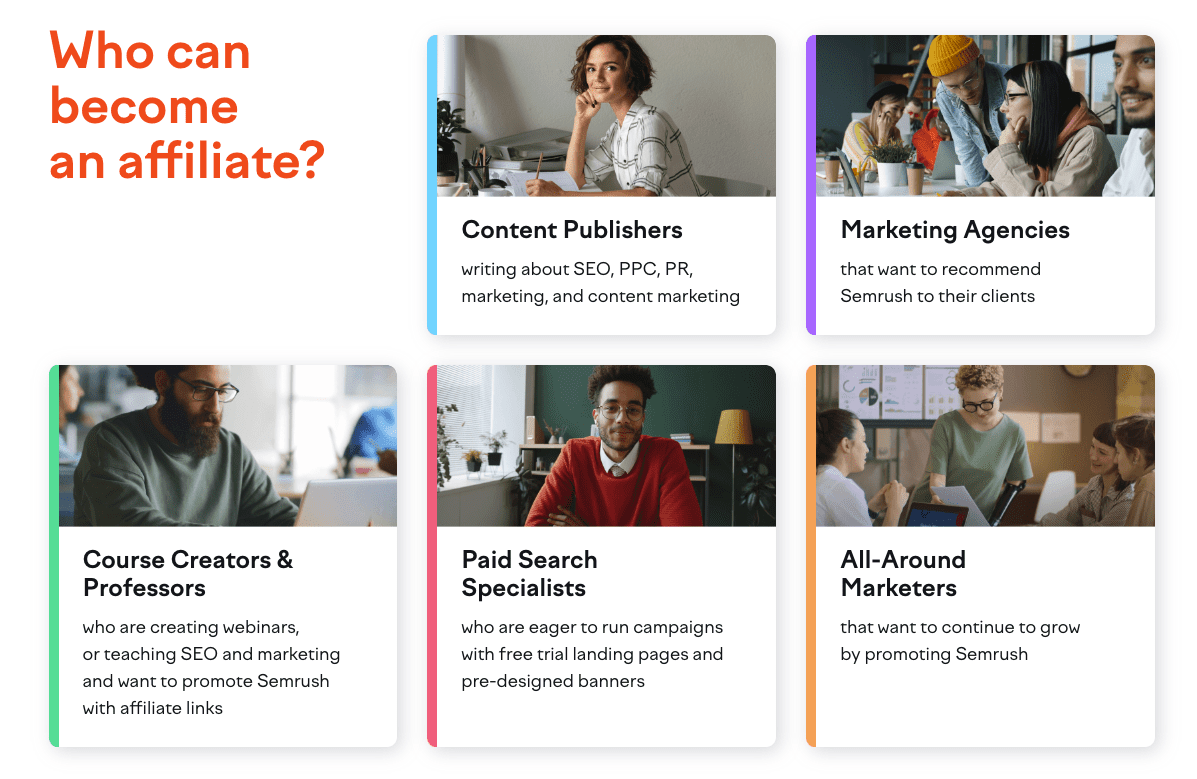


Semrush is a SaaS marketing platform with over 10 million users for marketers who want to increase online visibility.
Its comprehensive suite of over 50 tools supports businesses in enhancing their online presence through SEO, PPC advertising, content management, social media strategies, and competitive research.
The Semrush Affiliate Program offers $200 for each sale and $10 for every free trial initiated through its referral.
With a last-click attribution model and 120-day cookie duration, top affiliates earn with pre-designed promotional materials and support from a dedicated team.
The program’s tiered commission structure starts at $200 per sale, with potential increases, additional bonuses based on quarterly sales performance, and varying support and resources tailored to each tier.
8. Similarweb
Similarweb offers a partnership program designed to enable businesses using its product to grow by leveraging their industry-leading digital measurement tools.
By joining, partners can earn a revenue share from premium solutions sold, access co-marketing resources, receive support, and gain certification as digital measurement experts.
First, applicants must become certified as a Marketing Intelligence expert. Then, as certified partners, they begin their growth journey with Similarweb.
Social Media Management Tools
9. Hootsuite
Hootsuite, a leading social media management tool, offers an affiliate program that allows individuals to earn commissions by referring new users to its Professional and Team Plans.
Applicants, once approved, receive a unique affiliate link and access to the Affiliate Brand Kit, enabling them to customize content and track referrals.
Commissions are earned for each new qualifying user who signs up through the affiliate link, with higher earnings for those who opt for the Team plan.
Businesses can also refer Enterprise customers via the Partner Program.
10. Sendible
Sendible offers a comprehensive affiliate program, encouraging participants to promote its social media management platform.
New affiliates can earn a 12% lifetime commission for each new customer they successfully refer.
After referring over 100 customers, affiliates move into a higher tier where they can earn 30% per referred customer for the first 12 months.
Payments are submitted through PayPal, with commissions calculated based on the customer’s continued subscription.
Creative Content Platforms
11. Adobe
The Adobe Affiliate Program allows creatives to earn commissions by promoting Adobe Creative Cloud, Adobe Stock, and Adobe Document Cloud on their websites, blogs, or social media channels.
Affiliates benefit from an impressive commission structure, including 85% of the first month’s payment for Creative Cloud and Document Cloud monthly and yearly subscriptions and 8.33% for yearly subscriptions paid annually.
The program features a 30-day cookie duration, provides marketing materials, offers regular promotions, and gives access to detailed product performance reports.
However, it’s noted that commissions are not awarded for trial, invalid, or fraudulent orders, and availability may vary by country.
12. Canva
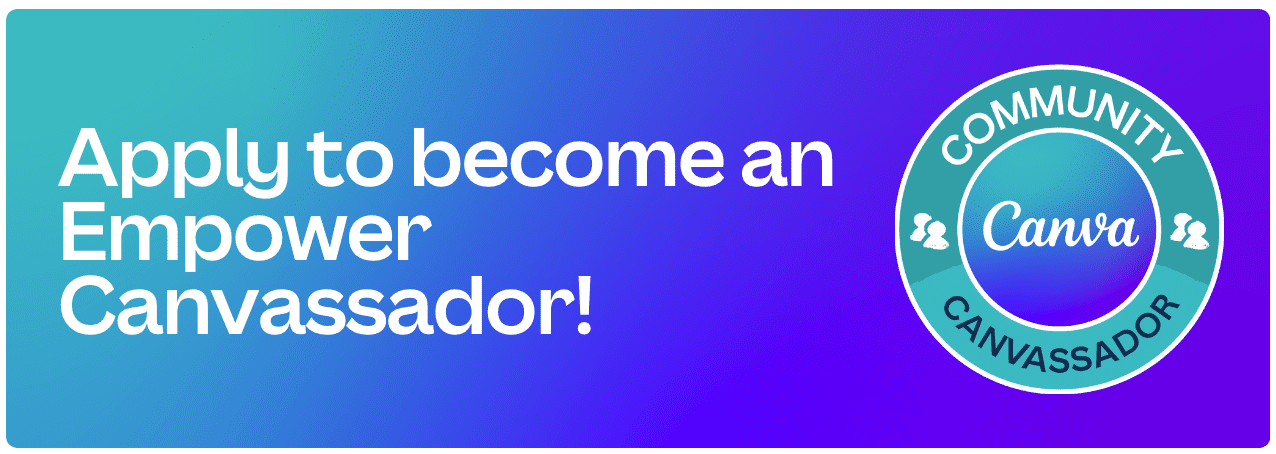


Canva rebranded its affiliate program as the Empower Canvassador program. It aims to empower content creators to inspire and uplift people worldwide, particularly within the Canva community.
Ideal candidates are engaged social media content creators, workshop facilitators, podcasters, and course developers active on platforms like Instagram, X (Twitter), TikTok, YouTube, Facebook, and LinkedIn.
To become an Empower Canvassador, individuals must embody Canva’s values, operate independently (not as a brand or agency), have an active and engaged audience, and commit to creating at least one piece of Canva-related content monthly.
Benefits include a special Canvassador badge, beta testing opportunities, educational resources, collaboration chances with Canva, weekly updates, affiliate commissions on Canva Pro conversions, and exclusive swag.
13. Shutterstock
Shutterstock is a global marketplace for sourcing stock photographs, vectors, illustrations, videos, and music.
The Shutterstock Affiliate Program allows partners to earn a 20% revenue share on net sales from images, footage, or music purchases for up to $300 per new customer.
This program features cookie-based tracking for 30-day credit post-click, automatic monthly payments through PayPal or e-transfer, and dedicated support to enhance performance and earnings.
Marketing Platforms
14. HubSpot
HubSpot offers a compelling affiliate program for content creators aiming to monetize their content while assisting businesses in their growth, featuring a 30% recurring commission for up to a year, tiered payouts, a 180-day cookie window, a large library of promotional materials, reliable support, and comprehensive performance reports.
Designed for SaaS reviewers, content creators, digital educators, and those offering product integrations with HubSpot, the program promotes growth by rewarding increased referrals with higher tiers, offering additional bonuses for Super and Elite Affiliates, and providing resources like a welcome bonus, an affiliate resource center, and personalized support to optimize affiliate success.
HubSpot also offers a Partner program, which is ideal for businesses consulting on strategy, tech implementation, or hands-on services in marketing, sales, or customer service.
15. Salesforce
The Salesforce Partner Program is designed to elevate businesses by offering access to the world’s No. 1 trusted platform – complete with tools, training, and resources to foster app development, expertise growth, demand generation, and sales efficiency.
Companies in the program can utilize free co-marketing resources, technical consultations, and visibility through AppExchange listings to scale their solutions and business operations efficiently.
Website Builders
16. WordPress
The WordPress/Automattic Affiliate Program for WordPress.com, Jetpack, and WooCommerce targets WordPress professionals like site and plugin developers, designers, and theme creators.
Participation in the program is invite-only. Eligible affiliates earn a 20% commission on qualifying purchases. Payments are issued via Tipalti, which supports various methods like PayPal and wire transfer.
To stay in the program, affiliates must maintain a minimum of $100 in accrued rewards, and all transactions must occur within 30 days of the referral link being clicked.
17. Squarespace



Squarespace offers a platform that empowers millions to establish a significant online presence, making it simple for anyone to share their passions globally.
By joining its affiliate program, individuals have the opportunity to earn commissions by encouraging their audience to explore and subscribe to Squarespace’s services, which range from website to commerce subscriptions for first-time customers.
This program is designed without limits on referral counts, enabling unlimited earning potential. It is also supported by comprehensive resources, including creative assets, tracking tools, and regular updates to ensure affiliate partners are well-equipped to succeed.
Participation is free and open worldwide. It requires a single application for multiple websites, contingent on adherence to program terms and relevant content guidelines.
18. Wix
The Wix affiliate program boasts competitive payouts for every conversion, allowing for rapid income generation with no cap on referrals.
Affiliates are provided with various creative resources and an intuitive dashboard to efficiently manage campaigns, track traffic, and monitor earnings.
19. Web.com
Web.com offers an affiliate program for individuals to earn by promoting a range of web services, including the company’s website builder and hosting products.
The program promises accurate tracking through a leading platform and unlimited earning potential with a $100 commission for each qualified purchase, with payments submitted via direct deposit or check.
Ecommerce Platforms
20. Shopify
Shopify, a top ecommerce solution provider, encourages educators, influencers, review sites, and content creators to participate in its affiliate program.
To qualify for the Shopify Affiliate Program, applicants must own an active website, have a substantial audience, produce original content (such as online courses, blog posts, videos, or guides), possess knowledge in commerce or ecommerce platforms like Shopify, and agree to Shopify’s Affiliate Marketing Program Terms.
Affiliates use Impact, a third-party platform, to track referrals, report in real time, and receive monthly commission payments.
Approved affiliates can earn up to $500 in commission based on the product and the location of the referred merchants, with a minimum payout threshold of $10 USD through Impact, direct deposit, or PayPal.
21. BigCommerce
BigCommerce is a leading ecommerce platform with open SaaS, headless integrations, omnichannel, B2B, and offline-to-online solutions.
It offers an affiliate program where affiliates can earn 200% of a new customer’s first monthly payment or $1,500 for each enterprise customer referral.
Affiliates can also earn $1.50 for registrations and $40 per enterprise lead, with a 90-day referral period applicable for all types of referrals.
Elearning & Online Courses
22. Coursera
The Coursera affiliate program allows content creators to monetize its platform by promoting over 4,000 courses from hundreds of universities and companies, such as Amazon, Gitlab, Google, HubSpot, Intuit, Meta, Microsoft, NVIDIA, Salesforce, Tencent Cloud, VMware, Yandex, and Zoho.
Affiliates can earn 15% to 45% commissions on qualified purchases made by new and existing customers within a 30-day cookie window, alongside bonuses for exceptional performance.
Coursera also offers plans for teams and enterprises, allowing affiliates to make commissions from high-ticket sales.
23. Thinkific
Thinkific is an online course creation platform with users enrolled in over 387 million courses.
Earn up to $1,700 per referral annually through the Thinkific affiliate program.
24. Teachable
Teachable is an online course platform used by over 100,000 entrepreneurs, creators, and businesses of all sizes to create engaging online courses and coaching businesses.
Thinkific wants affiliates who are DIY content creators, entrepreneurs, and business owners interested in sharing their expertise or catering to their customers with online courses.
The Thinkific Affiliate Program offers a 30% recurring commission on any monthly or annual paid plans through PartnerStack.
Affiliates can utilize exclusive promotional materials and a generous 90-day cookie tracking period, ensuring credit for referrals who sign up within that timeframe.
Email Marketing & Marketing Automation
25. ActiveCampaign
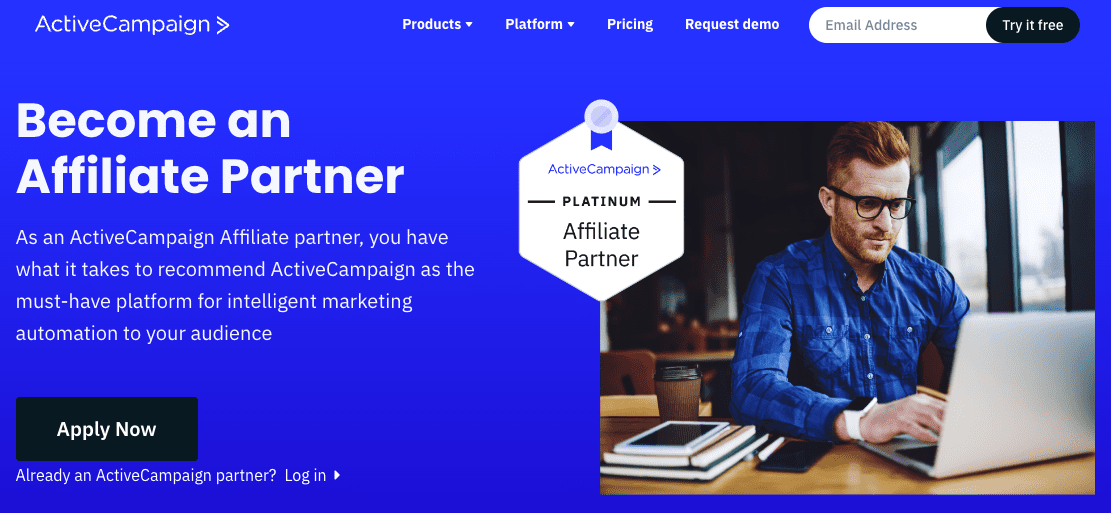


ActiveCampaign offers an affiliate program with recurring commissions of 20% to 30% from new customer sales and the potential to receive up to $1,350 with one sale.
The program is designed to be accessible to anyone interested in participating, regardless of whether they are current ActiveCampaign customers.
Affiliates receive a unique referral link upon signing up and access to a suite of resources, including graphics, webinars, and a dashboard to track progress.
26. Aweber
AWeber, an email marketing platform known for its affordability, offers a customer referral program for its users to promote landing pages, ecommerce, and more.
The program offers up to 50% lifetime recurring commission for new accounts. “Advocates” start with a 30% commission rate, which increases to 40% after referring ten new paid accounts and 50% after referring 50 within a 12-month period.
27. Contact Contact
Constant Contact, a trusted email marketing solution for over two decades, offers an affiliate program for small businesses, bloggers, and entrepreneurs to earn up to $105 for each new paid account referral.
This program is ideal for those committed to helping smaller entities thrive in competitive markets.
28. GetResponse
GetResponse, a comprehensive email and marketing automation platform, offers two types of affiliate programs.
With the Recurring Program, you can earn a continuous commission of 33% every month. With the Bounty Program, you can earn an upfront commission of $100 per sale.
Web Hosting
29. DreamHost
DreamHost web hosting supports WordPress and WooCommerce websites with basic, managed, and VPS solutions. Affiliates can earn up to $200 per referral and recurring monthly commissions with the DreamHost affiliate program.
The program also offers a range of ready-to-use creative banners and an intuitive dashboard to track sales.
30. Kinsta
Kinsta is a web hosting provider that manages WordPress, applications, and database hosting.
Kinsta’s affiliate program offers the opportunity to earn 5% to 10% in lifetime monthly commissions by referring customers to its hosting services.
The program provides a simple commission model with different commission rates depending on the type of hosting service referred, such as managed WordPress hosting, application hosting, or database hosting.
Commissions range from a one-time commission between $50 to $500 plus 10% recurring monthly commissions for WordPress packages to 5% for à la carte resource-based services.
31. Flywheel
Flywheel provides managed WordPress hosting for agencies, ecommerce, and high-traffic websites.
Earn up to $500 per new referral from the Flywheel affiliate program.
Tools For Privacy & Security
32. Sucuri
Sucuri is a cloud-based security platform with experienced security analysts offering malware scanning and removal, protection from hacks and attacks, and better site performance.
Join Sucuri referral programs for the platform, firewall, and agency products and earn up to $124 per new sale.
33. Smartproxy
Smartproxy allows customers to access business data worldwide for competitor research, search engine results page (SERP) scraping, price aggregation, and ad verification.
Earn up to $2,500 per customer that you refer to Smartproxy using its affiliate program.
34. ADT
ADT is a security systems provider for residences and businesses.
The ADT Rewards Program is an exclusive program that allows current ADT customers to receive a $200 Visa Reward Card per new customer referral.
How To Find Affiliate Marketing & Partner Programs
In addition to the high-ticket affiliate marketing and partner programs listed above, you can find more programs to join with a little research.
- Search for affiliate or referral programs for all of the products or services you have a positive experience with, personally or professionally.
- Search for partner programs for products and services your organization uses and can confidently recommend to others.
- Search for products and services that match your audience’s needs on affiliate platforms like Shareasale, Awin, CJ, PartnerStack, Rakuten, and FlexOffers.
- Follow influencers in your niche to see what products and services they recommend. They may have affiliate or referral programs as well.
A key to affiliate marketing success is to diversify the affiliate marketing programs you join.
It will ensure that you continue to generate an affiliate income, regardless of whether one company changes or shutters its program.
Conclusion
The first step to affiliate marketing is to build a dedicated following. From there, you must choose affiliate products that align with your personal and brand ethos to maximize your earnings.
Trust and authenticity are critical for success. Audiences must trust that you are sincere in your recommendations and be willing to click through. Platforms and services you already use and love make great candidates for affiliate programs.
Adopting a strategic and authentic approach to affiliate marketing can enhance your digital footprint, provide value to your audience, and open up new revenue streams.
More resources:
Featured Image: fatmawati achmad zaenuri/Shutterstock



